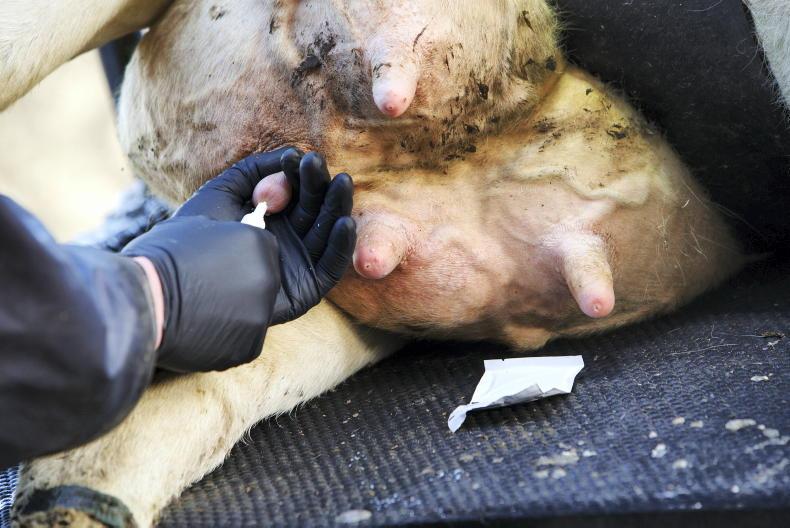Following on from a meeting of his local CAFRE Business Development Group, Dairylink farmer James King has been reassessing his parlour setup and milking routine.
The group reviewed the benefits of undertaking a dynamic milking machine test with Kathryn George, CAFRE Dairylink adviser and Norman Beggs, Udder Health Solutions.
Unlike a static test, which simply measures vacuum in various parts of the milking plant, the dynamic test will give an indication of what is happening at cow level.
“A dynamic test will measure the vacuum inside the liner below the teat, at the base of the teat, and will also look to see how the liner is interacting with the wall of the teat,” explains Kathryn George.
The aim in any parlour should be to get cows milked quickly and efficiently, without causing any injury to teats.
There are a number of factors that can dictate the extent of hyperkeratosis
Infections may be due to issues related to milking machines. When the teat end is in good condition, it is best placed to provide a natural barrier to pathogens.
A good indicator of potential problems is hyperkeratosis, which is a thickening of the skin that lines the teat canal and around the end of the teat.
There are a number of factors that can dictate the extent of hyperkeratosis, and in general it is more severe in cows with long, pointed teats, slow milkers or high-producing animals.
However, according to Kathryn George, both the liner and the extent of the vacuum will also have an impact. In general, the higher the vacuum or the tougher the liner, the higher the pressure on the teat end.
Swelling disturbs blood flow within the teat, leading to the tip becoming stiff, ultimately resulting in slower milkings and more mastitis
But if the liner compression is too low, it can lead to problems with teat swelling. That happens when the vacuum surrounds the whole teat, either because the liner is too wide a gauge, or because the teat is short and does not fit well into the barrel of the liner.
Swelling disturbs blood flow within the teat, leading to the tip becoming stiff, ultimately resulting in slower milkings and more mastitis as the teat ends remain open for a prolonged period after milking.
Settings
However, not all issues are due to the vacuum or the liners, and it is important to ensure that pulsation is correct and that cows are not being over-milked due to automatic cluster removers being wrongly set.
“The other issue on farms is pre-milking routine. It is important to stimulate the teat by touching it (dry wiping or stripping) and then waiting for up to 80 seconds before attaching the clusters,” explains Kathryn George.
In cows, around 20% of milk is readily available, but up to 80% is held in glands that need to be squeezed out by the cow.
If the clusters are attached immediately, the milk that is readily available will flow, but then there is a gap until the remaining milk is let down. In this period, the vacuum on the teat rises, leading to potential damage to the teat.
Results of test
Poor milk letdown should be among the issues identified in a dynamic milking machine test, as it can show if there is a spike in vacuum pressure about 30 seconds into a milking.
The test results will also identify where cows are being over-milked or where there is poor liner fit.
While all cows are different, the advice is to pick a liner that is suited to the majority of the herd, but remember that oversized liners are likely to do more damage to teats than the other way around.
Changed
Liners should be replaced according to manufacturer guidelines and James has recently changed his in preparation for the autumn/winter-calving season. Where the guideline is to change the liner after 2,500 milkings, use the following calculation to work out the working life for each set: 2,500 x no. of milking units / herd size x no. of milkings per day.
On the King farm, this works out at just over five months.
“It is important to change the liners before they get worn, and probably also worthwhile to split a couple of the old liners, just to check that you haven’t left it too long.
“At the same time, James has also checked all the milk and air lines to make sure there are no twists, and that the milk lines are not too long which could drop vacuum inside the liner,” says Kathryn.
Milk recording
As well as parlour maintenance, James has acted on his latest milk recording on 15 September by selecting a number of high cell count cows for culling and giving others an extended dry period.
Read more
Abundance of forage in Monaghan
Watch: Dairylink participant Richard Marshall's virtual farm walk and talk
Following on from a meeting of his local CAFRE Business Development Group, Dairylink farmer James King has been reassessing his parlour setup and milking routine.
The group reviewed the benefits of undertaking a dynamic milking machine test with Kathryn George, CAFRE Dairylink adviser and Norman Beggs, Udder Health Solutions.
Unlike a static test, which simply measures vacuum in various parts of the milking plant, the dynamic test will give an indication of what is happening at cow level.
“A dynamic test will measure the vacuum inside the liner below the teat, at the base of the teat, and will also look to see how the liner is interacting with the wall of the teat,” explains Kathryn George.
The aim in any parlour should be to get cows milked quickly and efficiently, without causing any injury to teats.
There are a number of factors that can dictate the extent of hyperkeratosis
Infections may be due to issues related to milking machines. When the teat end is in good condition, it is best placed to provide a natural barrier to pathogens.
A good indicator of potential problems is hyperkeratosis, which is a thickening of the skin that lines the teat canal and around the end of the teat.
There are a number of factors that can dictate the extent of hyperkeratosis, and in general it is more severe in cows with long, pointed teats, slow milkers or high-producing animals.
However, according to Kathryn George, both the liner and the extent of the vacuum will also have an impact. In general, the higher the vacuum or the tougher the liner, the higher the pressure on the teat end.
Swelling disturbs blood flow within the teat, leading to the tip becoming stiff, ultimately resulting in slower milkings and more mastitis
But if the liner compression is too low, it can lead to problems with teat swelling. That happens when the vacuum surrounds the whole teat, either because the liner is too wide a gauge, or because the teat is short and does not fit well into the barrel of the liner.
Swelling disturbs blood flow within the teat, leading to the tip becoming stiff, ultimately resulting in slower milkings and more mastitis as the teat ends remain open for a prolonged period after milking.
Settings
However, not all issues are due to the vacuum or the liners, and it is important to ensure that pulsation is correct and that cows are not being over-milked due to automatic cluster removers being wrongly set.
“The other issue on farms is pre-milking routine. It is important to stimulate the teat by touching it (dry wiping or stripping) and then waiting for up to 80 seconds before attaching the clusters,” explains Kathryn George.
In cows, around 20% of milk is readily available, but up to 80% is held in glands that need to be squeezed out by the cow.
If the clusters are attached immediately, the milk that is readily available will flow, but then there is a gap until the remaining milk is let down. In this period, the vacuum on the teat rises, leading to potential damage to the teat.
Results of test
Poor milk letdown should be among the issues identified in a dynamic milking machine test, as it can show if there is a spike in vacuum pressure about 30 seconds into a milking.
The test results will also identify where cows are being over-milked or where there is poor liner fit.
While all cows are different, the advice is to pick a liner that is suited to the majority of the herd, but remember that oversized liners are likely to do more damage to teats than the other way around.
Changed
Liners should be replaced according to manufacturer guidelines and James has recently changed his in preparation for the autumn/winter-calving season. Where the guideline is to change the liner after 2,500 milkings, use the following calculation to work out the working life for each set: 2,500 x no. of milking units / herd size x no. of milkings per day.
On the King farm, this works out at just over five months.
“It is important to change the liners before they get worn, and probably also worthwhile to split a couple of the old liners, just to check that you haven’t left it too long.
“At the same time, James has also checked all the milk and air lines to make sure there are no twists, and that the milk lines are not too long which could drop vacuum inside the liner,” says Kathryn.
Milk recording
As well as parlour maintenance, James has acted on his latest milk recording on 15 September by selecting a number of high cell count cows for culling and giving others an extended dry period.
Read more
Abundance of forage in Monaghan
Watch: Dairylink participant Richard Marshall's virtual farm walk and talk









SHARING OPTIONS